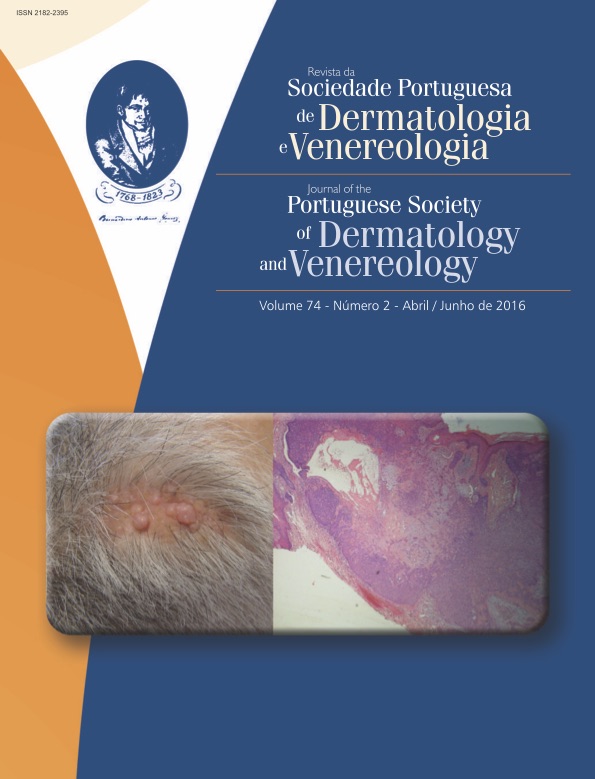Reacções Cutâneas, Oculares e Respiratórias pela Processionária (Thaumetopoea Pityocampa)
Resumo
A lagarta do pinheiro, Thaumetopoea pityocampa, é um inseto desfolhador responsável pelo atraso do crescimento ou a morte de vários tipos de pinheiros. Além de danos ambientais a lagarta pode provocar reações cutâneas em humanos pelo contato com os pelos irritantes das larvas. Embora a dermatite ocorra entre grupos de profissionais de ar livre, afecta principalmente grupos não-ocupacionais. Os meios de transmissão compreendem o contato directo com o ninho e/ou processionária e o contato indireto com os pelos dispersos no ar. A dermatite é geralmente observada no final da Primavera, particularmente, de Março a Junho, entre os ultilizadores de parques de campismo. A erupção cutânea tem início 1-12 horas após o contato com os pêlos e apresenta-se com prurido intenso e persistente. Para além da pele, a T. pityocampa pode envolver a olhos e a via aérea, mas de forma menos frequente. Apesar dos danos consideráveis para os seres humanos e para natureza, a infestação é um problema subestimado; a literatura médica é escassa e, muitas vezes, a informação relevante é a que se refere aos meios de comunicação locais e à sabedoria popular.
Downloads
Referências
Mallet J. The Lepidoptera Taxome Project Draft Proposals and Information, 2007. [accessed March 2015] Available
at: http://www.ucl.ac.uk/taxome/lepnos.html.
Hossler EW. Caterpillars and moths. Part II. Dermatologic manifestations of encounters with Lepidoptera. J Am Acad
Dermatol. 2010; 62:13-28.
Hossler EW. Caterpillars and moths. Dermatol Ther. 2009; 22:353-66.
R.A.F. De Reaumur, Mémoire pour servir à l’histoire des insects. Paris: Imprimerie Royale; 1736.
J. H. Fabre, Un virus des insectes, Masson, 1898.
Hódar JA, Castro J, Zamora R. Pine processionary caterpillar Thaumetopoea pityocampa as a new threat for relict
Mediterranean Scots pine forests under climatic warming. Biol Conserv.2003; 110:123-9.
Solt I, Mendel Z. The pine processionary caterpillar Thaumetopoea pityocampa. Harefuah.2002; 141: 810-57.
Battisti A, Stastny M, Netherer S, Robinet C, Schopf A, Roques A, at al. Expansion of geographic range in the pine
processionary moth caused by increased winter temperatures. Ecological Applications. 2005; 15:2084-96.
Fagrell B, Jorneskog G, Salomonnson AC, Larsson S, Holm C. Skin reactions induced by experimental exposure
to setae from larvae of the northern pine processionary moth (Thaumetopoea pinivora). Contact Dermatitis.2008;
:290-5.
Battisti A, Holm G, Fagrell B, Larsson S. Urticating hairs in arthropods: their nature and medical significance. Annu
Rev Entomol.2011; 56:203-20.
Vega JM, Moneo I, Armentia A, Fernández A, Vega J, de la Fuente R, et al. Allergy to the pine processionary caterpillar (Thaumetopoea pityocampa). Clin Exp Allergy. 1999; 29:1418-23.
Vega JM, Moneo I, Garcia Ortiz JC, Sánchez Palla P, Sanchís ME, Vega J, et al. Prevalence of cutaneous reactions to pine processionary moth (Thaumetopoea pityocampa) in an adult population. Contact Dermatitis.2011;64:220-8.
Vega JM, Moneo I, Armentia A. Anaphylaxis to a pine caterpillar. Allergy. 1997; 52:1244-5.
Vega JM, Moneo I, Armentia A, Vega J, de la Fuente R, Fernández A. Pine processionary caterpillar as a new
cause of immunologic contact urticaria. Contact Dermatitis. 2000; 43:129-32.
Vega ML, Vega J, Vega JM, Moneo I, Sanchéz E, Miranda A. Cutaneous reactions to pine processionary caterpillar
(Thaumetopoea pityocampa) in pediatric population. Pediatr Allergy Immunol.2003; 14:1-5.
Lamy M, Pastureaud MH, Novak F, Ducombs G, Vincendeau P, Maleville J, et al. Thaumetopoein: an urticating
protein from the hairs and integument of the pine processionary caterpillar (Thaumetopoea pitycampa Schiff., Lepidoptera, Thaumetopoeidae). Toxicon.1986; 24:347-56.
Rodriguez-Mahillo AI, Gonzalez-Muñoz M, Vega JM, López JA, Yart A, Kerdelhué C, et al. Setae from the pine
processionary moth (Thaumetopoea pityocampa) contain several relevant allergens. Contact Dermatitis. 2012;
:367-74.
Vega JM, Vega J, Vega ML, Moneo I, Armentia A, Sánchez B. Skin reactions to pine processionary caterpillar. Allergy.
; 58:87-8.
Inal A, Altintaş DU, Güvenmez HK, Yilmaz M, Kendirli SG. Life-threatening facial edema due to pine caterpillar mimicking an allergic event. Allergol Immunopathol. 2006;34:171-3.
Bonamonte D, Foti C, Vestita M, Angelini G. Skin reactions to pine processionary caterpillar Thaumetopoea
pityocampa schiff. ScientificWorldJournal. 2013; 2013:867431.
Todos os artigos desta revista são de acesso aberto sob a licença internacional Creative Commons Attribution-NonCommercial 4.0 (CC BY-NC 4.0).








